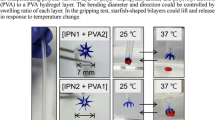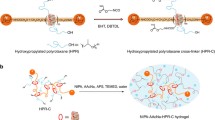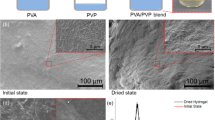Abstract
N-isopropylacrylamide (NIPAM)-based hydrogel films are used for touch-controlled applications, where the temperature-induced change in the mechanical properties is utilized to create tactile feedback. N,N′-methylenebisacrylamide (BIS) and poly(ethylene glycol)diacrylate (PEGDA) are used as cross-linkers to study the influence of their size and concentration on the viscoelastic properties in a temperature-controlled rheology setup. The changes in water content between swollen and collapsed state of the hydrogel samples increase with decreasing cross-linking density and increasing size of the cross-linker resulting in bigger meshes in the network. The difference in the viscoelastic properties of the hydrogels increases with increasing deswelling ratio and is highest for the P(NIPAM-PEGDA) hydrogels with low cross-linking density with a 50-fold increase in the storage modulus. The deswelling ratio of these P(NIPAM-PEGDA) hydrogels is up to five times higher compared to the P(NIPAM-BIS) hydrogels of the same cross-linking density. The mesh sizes are estimated from the mechanical properties.







Similar content being viewed by others
References
Haq MA, Su Y, Wang D (2017) . Mater Sci Eng C 70:842. https://doi.org/10.1016/j.msec.2016.09.081
Miruchna V, Walter R, Lindlbauer D, Lehmann M, von Klitzing R, Müller J (2015) .. In: Proceedings of the 28th Annual ACM Symposium on User Interface Software & Technology, UIST ’15, https://doi.org/10.1145/2807442.2807487
Kim CC, Lee HH, Oh KH, Sun JY (2016) . Science 353:682. https://doi.org/10.1126/science.aaf8810
Shibayama M, Tanaka T (1993) . Adv Polym Sci 109:1. https://doi.org/10.1007/3-540-56791-7-1
Ashraf S, Park H, Park H, Lee SH (2016) . Macromol Res 24:297. https://doi.org/10.1007/s13233-016-4052-2
Ahmed EM (2015) . J Adv Res 6:105. https://doi.org/10.1016/j.jare.2013.07.006
Zhao F, Yao D, Guo R, Deng L, Dong A, Zhang J (2015) . Nanomaterials 5:2054. https://doi.org/10.3390/nano5042054
Varghese S, Elisseeff JH (2006) . Adv Polym Sci 203:95. https://doi.org/10.1007/12-072
Fänger C, Wack H, Ulbricht M (2006) . Macromol Biosci 6:393. https://doi.org/10.1002/mabi.200600027
Son KH, Lee JW (2016) . Materials 9:1. https://doi.org/10.3390/ma9100854
Nayak S, Lyon LA (2005) . Angew Chem Int Ed 44:7688. https://doi.org/10.1002/anie.200501321
Xia LW, Xie R, Ju XJ, Wang W, Chen Q, Chu LY (2013) . Nat Commun 4:2226. https://doi.org/10.1038/ncomms3226
Matzelle TR, Geuskens G, Kruse N (2003) . Macromolecules 36:2926. https://doi.org/10.1021/ma021719p
Burmistrova A, Richter M, Eisele M, Üzüm C, von Klitzing R (2011) . Polymers 3:1575. https://doi.org/10.3390/polym3041575
Backes S, Krause P, Tabaka W, Witt MU, von Klitzing R (2017) . Langmuir 33:14269. https://doi.org/10.1021/acs.langmuir.7b02903. https://doi.org/10.1021/acs.
Di Lorenzo F, Hellwig J, von Klitzing R, Seiffert S (2015) . ACS Macro Lett 4:698. https://doi.org/10.1021/acsmacrolett.5b00228
Adrus N, Ulbricht M (2013) . React Funct Polym 73:141. https://doi.org/10.1016/j.reactfunctpolym.2012.08.015
Puleo GL, Zulli F, Povanelli M, Giordano M, Mazzolai B, Beccai L, Andreozzi L (2013) . React Funct Polym 73:1306. https://doi.org/10.1016/j.reactfunctpolym.2013.07.004
Klatzky R, Pawluk D, Peer A (2013) . Proc IEEE 101:2081. https://doi.org/10.1109/JPROC.2013.2248691
Arendt-Nielsen L, Chen AC (2003) . Neurophysiol Clin = Clin Neurophysiol 33:259. https://doi.org/10.1016/j.neucli.2003.10.005
Kato N, Sakai Y, Shibata S (2003) . Macromolecules 36:961. https://doi.org/10.1021/ma0214198
Grillet AM, Wyatt N, Gloe LM (2012) Polymer gel rheology and adhesion. https://doi.org/10.5772/36975
Park TG, Hoffman AS (1994) . J Appl Polym Sci 52:85. https://doi.org/10.1002/app.1994.070520110
Ebara M, Kotsuchibashi Y, Uto K, Aoyagi T, Kim YJ, Narain R, Idota N, Hoffman JM (2014) Smart hydrogels. https://doi.org/10.1007/978-4-431-54400-5-2
Anseth KS, Bowman CN, Brannon-Peppas L (1996) . Biomaterials 17:1647. https://doi.org/10.1016/0142-9612(96)87644-7
Jensen M, Bach A, Hassager O, Skov A (2009) . Int J Adhes Adhes 29:687
Calvet D, Wong JY, Giasson S (2004) . Macromolecules 37:7762. https://doi.org/10.1021/ma049072r
Pritz T (1998) . J Sound Vib 214:83. https://doi.org/10.1006/jsvi.1998.1534. https://doi.org/10.1006/jsvi.
Aangenendt FJ, Mattsson J, Ellenbroek WG, Wyss HM (2017) . Phys Rev Appl 8:014003. https://doi.org/10.1103/PhysRevApplied.8.014003
Schmidt S, Zeiser M, Hellweg T, Duschl C, Fery A, Möhwald H (2010) . Adv Funct Mater 20:3235. https://doi.org/10.1002/adfm.201000730
Fernandes PAL, Schmidt S, Zeiser M, Fery A, Hellweg T (2010) . Soft Matter 6:3455. https://doi.org/10.1039/c0sm00275e
Acknowledgements
Benjamin von Lospichl and Sarah Schatte are thanked for support with the rheology measurements, and Marc Griffel from the mass spectrometry analytic centre of the Institute of Chemistry at TU Berlin is acknowledged for his service.
Funding
The authors thank the Deutsche Forschungsgemeinschaft (KL1165/15-1) for financial support.
Author information
Authors and Affiliations
Corresponding author
Ethics declarations
Conflict of interest
The authors declare that they have no conflict of interest.
Additional information
Publisher’s note
Springer Nature remains neutral with regard to jurisdictional claims in published maps and institutional affiliations.
Supporting Information
The following file is available:
– SI: Details about the LC-MS analysis and the performed frequency sweeps in the rheological experiments.
M. Lehmann and P. Krause contributed equally to this work
Electronic supplementary material
Below is the link to the electronic supplementary material.
Rights and permissions
About this article
Cite this article
Lehmann, M., Krause, P., Miruchna, V. et al. Tailoring PNIPAM hydrogels for large temperature-triggered changes in mechanical properties. Colloid Polym Sci 297, 633–640 (2019). https://doi.org/10.1007/s00396-019-04470-0
Received:
Revised:
Accepted:
Published:
Issue Date:
DOI: https://doi.org/10.1007/s00396-019-04470-0




